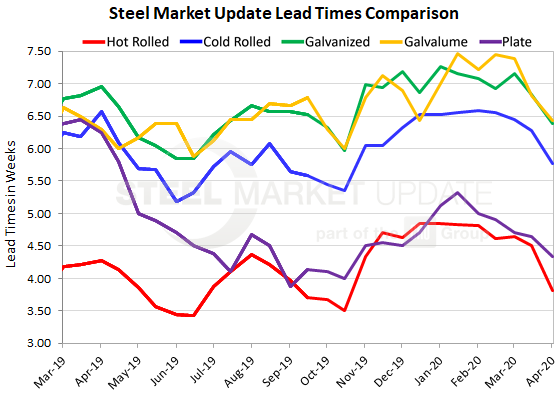SMU Data and Models

Steel Mill Lead Times: Getting Shorter
Written by Tim Triplett
April 5, 2020
Lead times for spot orders of flat rolled and plate are shortening as steps to control the coronavirus decimate demand. Lead times for steel delivery are a measure of demand at the mill level—the shorter the lead time, the less busy the mill. Average lead times for most products have shortened by roughly half a week since mid-March, according to returns from Steel Market Update’s latest market trends questionnaire.
Hot rolled lead times now average 3.81 weeks, down from 4.50 weeks two weeks ago. Cold rolled orders currently have a lead time of 5.77 weeks, down from 6.28 weeks earlier in March. The current lead time for galvanized steel is 6.39 weeks, compared with 6.84 weeks, while Galvalume is at 6.43 weeks, down from 6.82 weeks in SMU’s last check of the market.
Lead times for spot orders of plate products now average 4.33 weeks, down slightly from 4.64 weeks in mid-March.
The mills have announced a series of furnace idlings and production curtailments that should reduce their near-term capacity and help support lead times at the facilities still in operation.

Note: These lead times are based on the average from manufacturers and steel service centers who participated in this week’s SMU market trends analysis. Our lead times do not predict what any individual may get from any specific mill supplier. Look to your mill rep for actual lead times. Our lead times are meant only to identify trends and changes in the marketplace. To see an interactive history of our Steel Mill Lead Times data, visit our website here.

Tim Triplett
Read more from Tim TriplettLatest in SMU Data and Models

SMU Survey: Buyers’ Sentiment rebounds from multi-year low
Both of SMU’s Steel Buyers’ Sentiment Indices edged higher this week. Current Sentiment rebounded from a near five-year low, while Future Sentiment rose to a two-month high

SMU flat-rolled market survey results now available
SMU’s latest steel buyers market survey results are now available on our website to all premium members.

SMU Survey: Sheet lead times pull back after early-June blip, plate holds
Following the uptick seen two weeks ago, lead times eased this week for all four sheet products tracked by SMU, while plate lead times held steady, according to this week’s market survey.

SMU Survey: Pricing power abruptly shifts to steel buyers
The majority of steel buyers responding to our latest market survey say domestic mills are more willing to talk price on sheet and plate products than they were earlier this month. Sheet negotiation rates rebounded across the board compared to early June, while our plate negotiation rate hit a full 100%.

Service centers: Mill orders down marginally in May
SMU’s Mill Order Index (MOI) declined for a third straight month in May, but only marginally.
